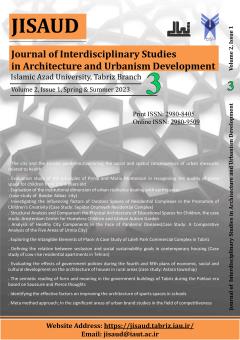Evaluation study of the principles of Pirnia with Maria Montessori in year-old recognizing the quality of game space for children from 2 to 6
Subject Areas :
Hirad Hosseinian
1
![]() ,
Sara Kalantar
2
,
Sara Kalantar
2
1 - Department of Architecture, Qazvin Branch, Islamic Azad University, Qazvin, Iran.(Corresponding Author)hirad_hosseinian@yahoo.com
2 - Master Researcher, Department of Architecture, South of Tehran Branch, Islamic Azad University, Tehran, Iran.
Keywords: Montessori, Pirnia, Iranian child culture, The quality of game space,
Abstract :
Throughout the history of early childhood education , various popular patterns and approaches have emerged that are still popular. The Montessori curriculum model is one of these models that is being used in our country . The purpose of this article is to examine the philosophical foundations of this model , and to analyze the nature of learning arising from it. For this purpose , using the regressive philosophical analytical method in the form of inferential approach , some philosophical foundations of this model were inferred and developed . These elements include ; holistic view of existence and the child and the need for holistic education, the child's individual and social aspects and emphasis on both aspects in education, the existence of spontaneous force within the child in the development path , attention to the child' s desires and the need to reveal his inner capacities , emphasis on different stages of development and provision of learning experiences tailored to the requirements of each stage , the child's freedom as a key element throughout the education process, the relative compatibility of the Montessori educational approach with the constructivist approach , providing a favorable learning environment in cooperation with nature. Then , using descriptive-analytical method , it became clear that the nature of learning in this model is similar to the findings of new research on learning that is based on competence , agency , multiple childhood and priority of children's lived experience. Toys are with the child from the birth , so that the ability of distinguishing tissues for children leads to increase information and its conformity to their surroundings. In this way, using of the child’ s sense and stimulating them , evokes the significant factors in direction of proper using from the quality of the game space. In this way and from the point of view of the Iranian culture and principle of the Iranian architecture and with using these senses , it can lead to intimacy and understanding the environment in a simple format. The individuality of the human beings has been considered in such a way that this word can lead to the understanding environmental culture for its audience. Therefore , we first tried to analyze and describe variables between principles of the Iranian architecture with theories of Maria Montessori , with an interpretive approach and consequential reasoning and understanding primary concepts in order to answer this question : “ how can find out the criteria to recognize the quality of game space for children from 2 to 6-year-old through matching Pirnia’s intellectual principles and theories of Maria Montessori? " By answering this question , the impact of the quality of the game space based on the Iranian architecture can be achieved and it is possible to boost sense of the children in the age of 2 to 6 -year -old through understanding of their surroundings , which requires a correct knowledge of the roots of Iranian architecture with education system of theorizing such as Montessori .
_||_


